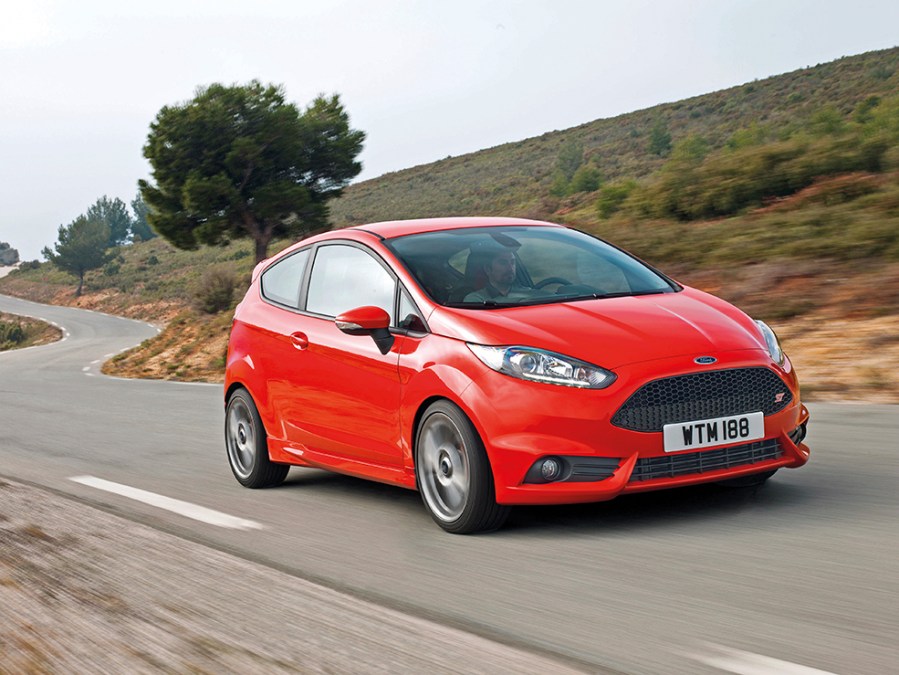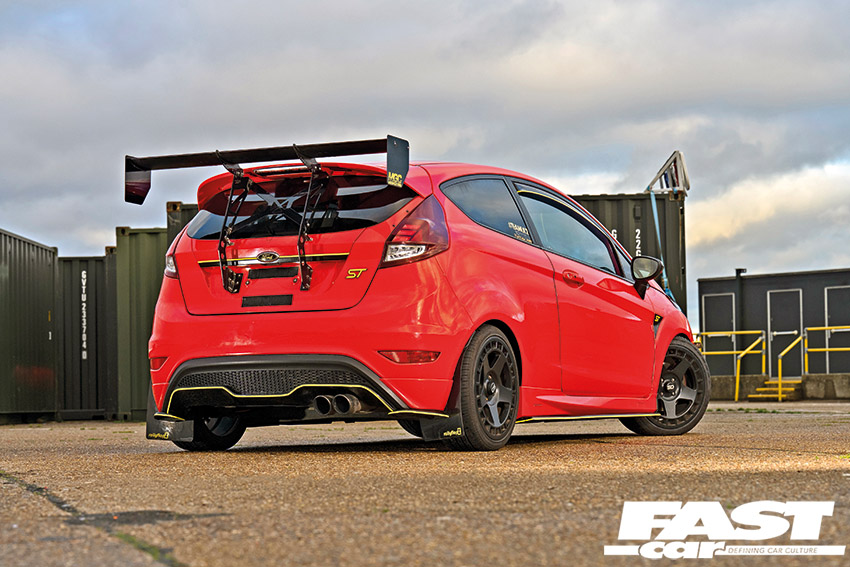The Ford Fiesta Mk7 ST 180 is one of the the finest small hot hatches in history, tearing up racetracks and B-roads with terrific performance, brilliant reliability, an affordable price and immense tuneability. Here’s what you need to know before buying the Mk7 Fiesta ST.
Why you want a Ford Fiesta Mk7 ST 180
- You want fun, yeah? There’s simply nothing else in this price bracket that will give you grins like an ST180, waving a back wheel at French contenders left trailing behind.
- Reliability and durability are almost flawless – whether you’re on track days or shopping trips, the Mk7 ST won’t let you down.
- Tuning a Ford Fiesta Mk7 ST180 is so easy – and safe – that it’s an embarrassment to other EcoBoost engines. Figures of 400bhp aren’t unheard of on standard internals.
Why you wouldn’t want a Ford Fiesta Mk7 ST
- Ride quality is a typical criticism, but what do you expect in a car that handles this well? Besides, top-quality lowering springs tend to improve comfort.
- ST180’s image is slightly tarnished by youngsters in Fiestas popping and banging outside McDonald’s.
- Bad modifications can take their toll on the 1.6 EcoBoost; some unscrupulous tuners will install overly-aggressive maps, resulting in severe engine trouble.
Key points to check when buying a Ford Fiesta Mk7 ST180
- Engine – Knocking or growling could be major bearing failure, and overheating leads to a damaged head. Poor running might be due to dodgy modifications, faulty fuel pump bucket or failed MAP.
- Transmission – Generally strong, but whining or difficult gear selection may mean a new gearbox is needed. Check for clutch slip or clicking from CV joints.
- Identity – Check the spec. Check the history, the VIN and any outstanding finance. Check there are two keys and that the seller isn’t using some dodgy Facebook account…
- Body – Beware of accident damage, even if there’s no other sign of the car being a write-off. Ensure the panel gaps are aligned, there are no creases underneath, poor paintwork, overspray or rusty rear arches.
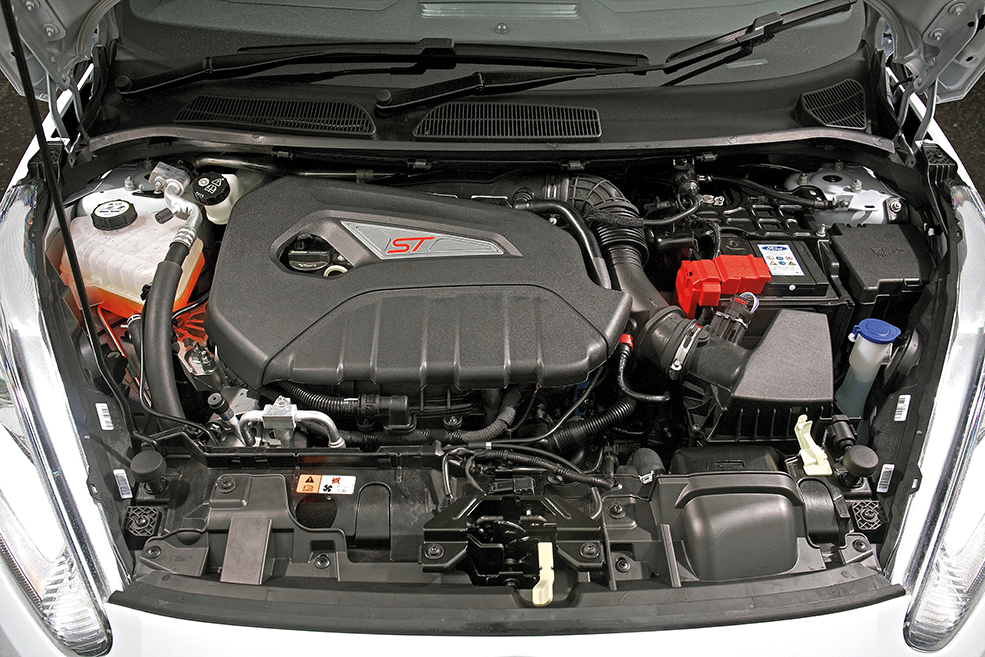
Ford Fiesta ST Mk7 Engine
Ignore all that EcoBoom nonsense – the Ford Fiesta Mk7 ST 180 and it’s 1.6-litre version is virtually bombproof. Collins Performance says forged internals are needed for 350bhp-plus, although some folk take their chances with 400bhp on a stock motor. Check out our Mk7 ST tuning guide for more tuning advice.
Engine failure is rare but not impossible. Some ST180s (especially modified) have had worn crankshaft bearings; listen for knocking at 3-4000rpm under load, especially when warm. Repair means a whole new bottom end.
Abuse from cold or poor servicing may be to blame, and EcoBoosts hate being run low on oil. Ensure the servicing has been kept up-to-date, with oil changes every 12,500 miles and cambelt at 125,000 miles; the water pump should be renewed at the same time because they sometimes leak and allow the engine to overheat.
Overheating
Some ST180s have also overheated – showing symptoms of cracked head or head gasket failure – due to sticking thermostat valves or shattered pipework between the header tank and head or turbo. On early STs, the pipework was plastic and could break easily, allowing coolant to escape and damage the engine, with little or no warning. Ford issued a recall in March 2017 for STs built prior to 20 December 2014 to receive updated rubber pipework and a new header tank with level sensor (as found in the Mk8 ST). Most affected Mk7s now have this setup, but check before buying. Even new header tanks can split around the cap, causing overheating; luckily, a new tank is only £40.
Beware of poor performance and heavy fuel consumption, which has a variety of causes. Often it’s the high-pressure fuel pump bucket, which may be rattling. It’s cheap to fix, but if not replaced could also lead to worn camshafts; look out for black smoke from the exhaust. The fuel pressure should be 170-to-200-bar, but tired or high-mileage cars can drop to 80.
Poor running could also be from a cracked sound symposer or failed MAP sensor; a diagnostic code suggests an airflow correlation fault, and people try boost pipes, MAFs and so on, but it’s usually the lower of the two MAPs – pricey from Ford but Collins supplies £30 Bosch equivalents.
If running flat and making a loud induction roar, the cause could be a flipped fuel vapour valve; it’s a cheap standard Fiesta part.
Modified Mk7 Fiesta ST180s
Modified STs can be awesome, but overly-aggressive maps can shorten the engine’s life. Beware of tuned cars unless you see receipts from respected tuners. Yes, you might like popping and banging maps, but they can damage the catalytic converter if poorly executed.
Collins advises keeping the original spark plugs unless mapped for different gaps. Aftermarket dump valves generally don’t perform well on the ST180 (the stock electronic valve works perfectly, although it can become weak and leak) and many induction kits have mis-sized airflow sensor housings, which cause the car to run lean or rich.
Be cautious of STs that have been modified and returned to standard – check for a de-cat.
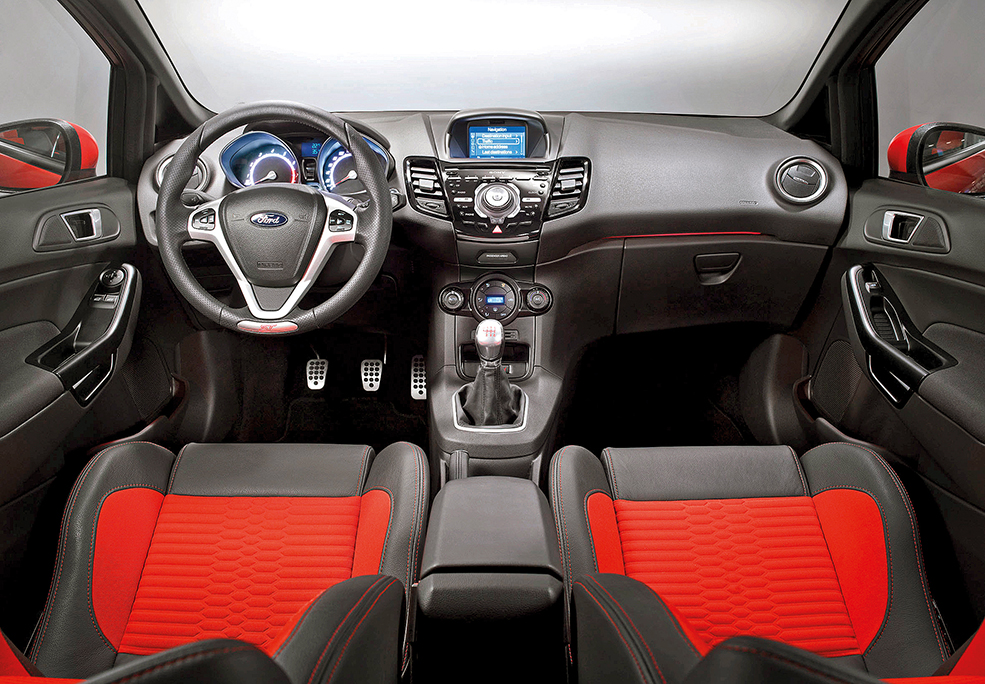
Ford Fiesta ST Mk7 Transmission
Six-speed Getrag B6 gearbox is ultra-tough, and will cope with loads of abuse. Even the standard AP clutch will take 340bhp without complaint, although several (stock) have failed at random.
Some early Mk7s experienced clutch or gearbox failure that was rectified under warranty, but keep your ears open for whining under load at low revs, which goes away when coasting. Listen, too, for clicking from CV joints or leaky driveshaft gaiters and grinding noises in neutral – pointing to release-bearing problems.
Several big-power STs have required gearbox replacement when a plastic bearing cup disintegrates and wears the ‘box; symptoms are excessive transmission noise and/or gear selection difficulties.
The standard gearshift is a bit vague, but it’s cured with a quickshift kit. Consider it a bonus if the car has been upgraded with a limited-slip differential (excellent for track days), but check the clutch and flywheel were replaced at the same time – ideally an ST200 clutch and quicker-accelerating 4.06:1 final drive, if you have the cash.
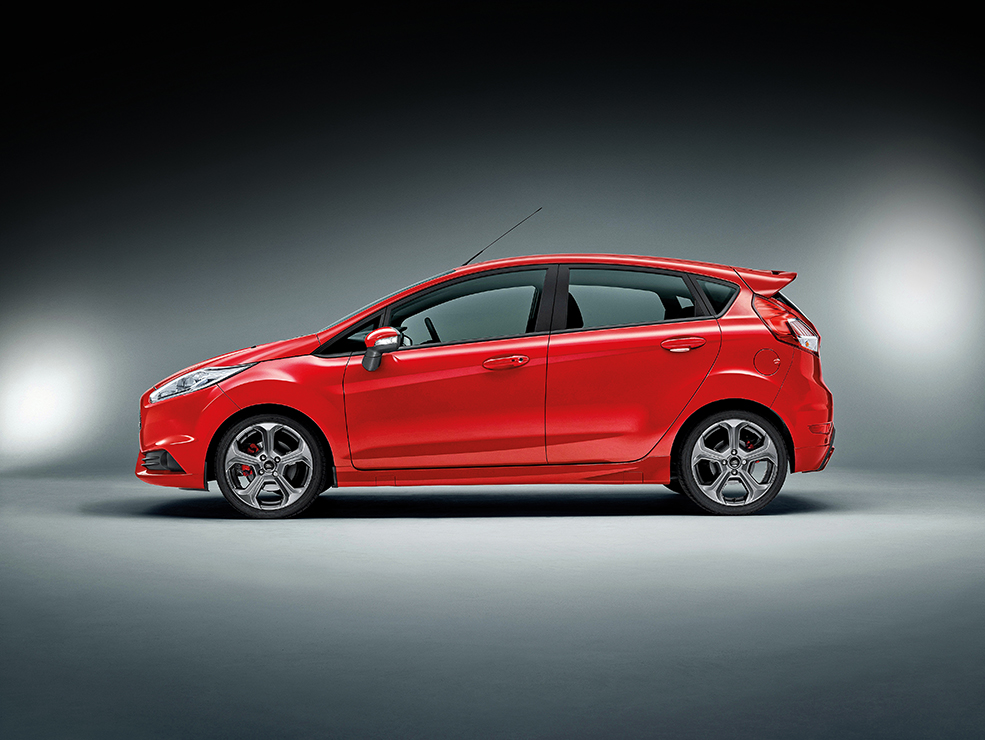
Ford Fiesta ST Mk7 Identity
ST 180s are adored by thieves, so your first job is to ensure the car you’re buying isn’t nicked. Invest in a proper history check (not the cheapest phone app you can find), ensuring it covers stolen cars, write-offs and outstanding finance – all ultra-relevant when it comes to any ST.
Take an OBDII code reader, and check the VIN on the logbook matches the car’s ECU. It should correspond with a tag at the left-hand-side of the dashboard (visible through the windscreen), stamped into the floor between the driver’s seat and pedals (under the mat), and on a sticker on the driver’s-side B-pillar: it should clearly display whether it’s an ST-1, ST-2, ST-3 or ST200 (which will read ST LIMITED EDN.). It will also include details of the car’s paint colour and interior trim.
The engine number should match the last seven digits of its VIN. You’ll find it on the V5 and also stamped into the engine block at the gearbox side, just in front of the starter motor. If it doesn’t tally, there could be a legitimate reason – such as engine failure – but ask questions.
Oh, and invest in security to ensure your ST doesn’t become a statistic. An OBDII relocation kit is a great start, while an aftermarket alarm and separate immobiliser will give you peace of mind.
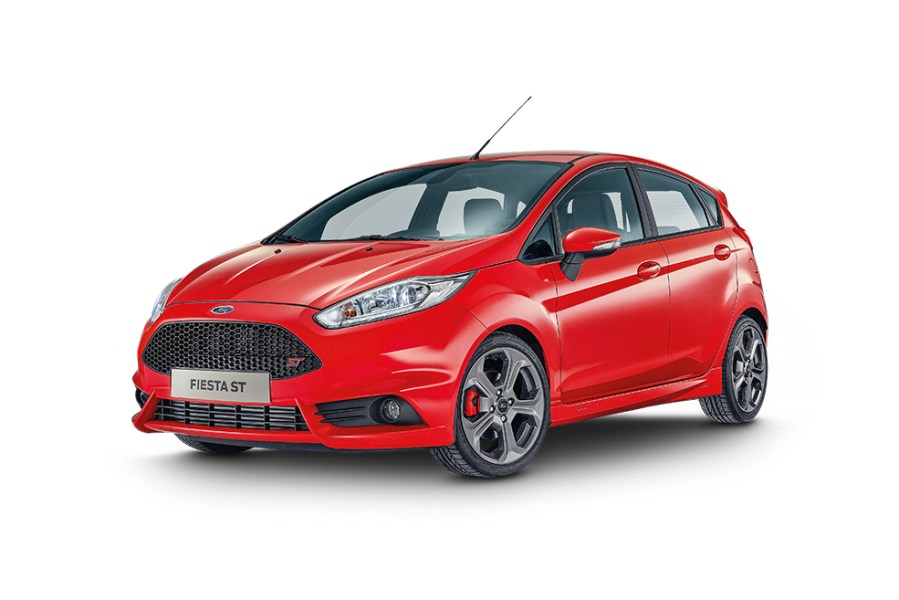
Chassis
Any Ford Fiesta Mk7 ST180 should feel razor-sharp; if not, look elsewhere. Its factory suspension – with uprated dampers, 15mm lowered height, modified steering knuckles and quicker PAS – is often criticised for being harsh, although smart people realise it’s a trade-off for such superb handling.
ST180s built from July 2016 gained beefier front anti-roll bar and stiffer rear beam, which is reckoned to improve comfort with no detriment to driveablity. Good-quality lowering springs tend to give a better ride, but excessive lowering upsets the balance. Spacers (10mm front, 15mm rear) are also worthwhile.
Look out for snapped coil springs – sometimes the front, but often the pigtails at the back. The foam rear upper spring isolators also fail, which are cheap and easy to change; upgrades offer a fit-and-forget solution.
Polyurethane bushes are a recommended upgrade for the ST, especially for the rear beam bushes, which on some cars are showing fatigue.
On the test drive, listen for clonking from the front and feel for wheel bounce or jerkiness when you let out the clutch. The subframe-to-gearbox mount wears quickly, and the offside engine mount might clonk under load –especially on thrashed cars. Uprated mounts are the cure.
Brakes
ST180 stoppers are fine for the road but have to work hard on track, so many owners fit high-performance pads or Brembos from a Renaultsport Clio (with brackets).
Look for uneven rear disc wear, typically caused by a calliper sticking on its slider. The fix is a new carrier (£144) or slider pin kit from eBay (£15), but greasing the pins at every service stops them from seizing.
Red callipers came with the Style Pack, alongside darker grey wheels than the stock silver; early Style Pack had Rado Grey. Rock Metallic was on the Style Pack from 2015, with Flash Grey as standard in 2016. ST200s had matt black spokes with polished rims. Metal (2014-2016) tyre valves leak, so check they’ve not been run when flat.
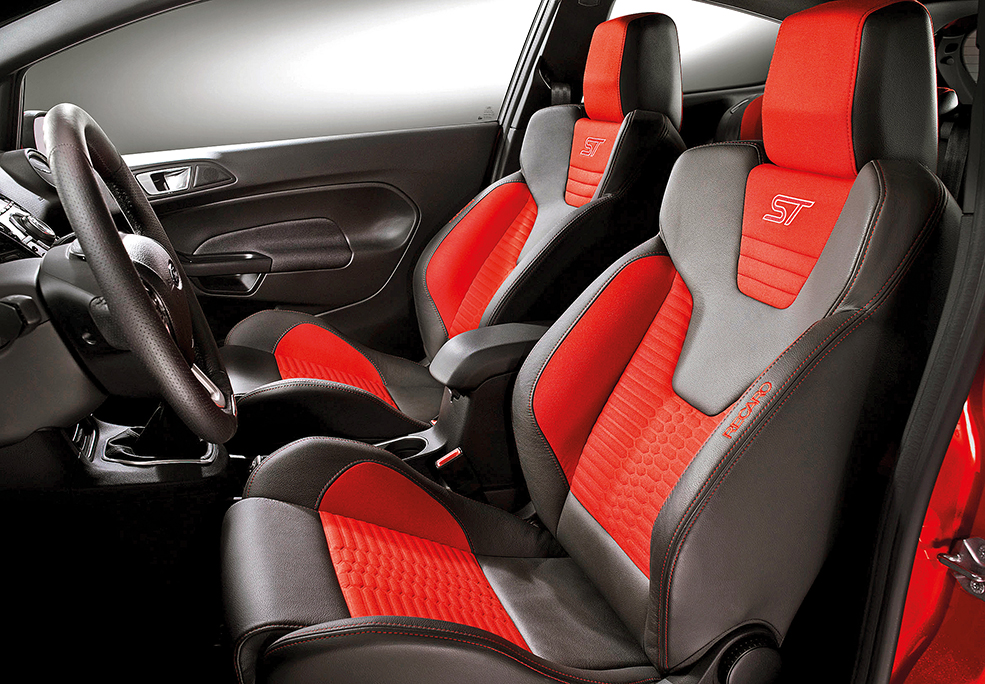
Ford Fiesta ST Mk7 Interior
You don’t expect any little Ford to be a premium product, so forgive the Fiesta Mk7 ST180 if its cabin feels flimsy. Listen for rattles from the dashboard and instruments, clattering from the door cards, and the A- and B-pillar trims sounding like they’re falling off; fix them back into place with foam pads. Squeaking from the clutch pedal is cured with WD-40. Front seats that won’t tip forward have probably had the cable pop off internally, but a replacement cable may be needed.
The trim is pretty hard-wearing, and tatty upholstery or worn-out seats are signs to avoid. Basic ST-1s had plain charcoal-coloured Recaros, with regular air conditioning, DAB radio and a heated windscreen. ST-2s added heated partial-leather seats (Molten Orange highlights were available with Panther Black, Frozen White or Molten Orange bodywork), Power Start button, privacy glass and LED DRLs. The ST-3 gained cruise control, climate control, keyless entry, auto headlights, rain-sensitive wipers, Powerfold mirrors and sat nav. An ST-2 with Convenience Pack should have keyless entry and Powerfold mirrors. A Style Pack should have illuminated scuff plates.
All ST200s were based on ST-3 Style Pack specification but added charcoal Recaros with silver detailing, seat belts with silver stitching, and fascia-mounted ST200 badge. It also included rear parking sensors, reversing camera and central rear head rest, which were optional on lesser STs.
Infotainment issues
DAB radios in early (pre-2014) cars were known for failure, requiring complete replacement. The SYNC system is also prone to playing up and failing to pair via Bluetooth, which is often cured by a software update or a fuse-out reboot. Some owners even discover it works better after reading the manual…
Test all the gadgets work property, especially the heated seats, sat nav and funky functions offered via the display menu, such as ambient lighting and rain-sensitive wipers. Press all the window switches, heater controls and locks to ensure they’re operational.
All Mk7s tend to leak rainwater into the boot, notably from the tailgate hinges or back lights. Check for puddles of water in the spare wheel well, and make sure the tailgate release button still works.
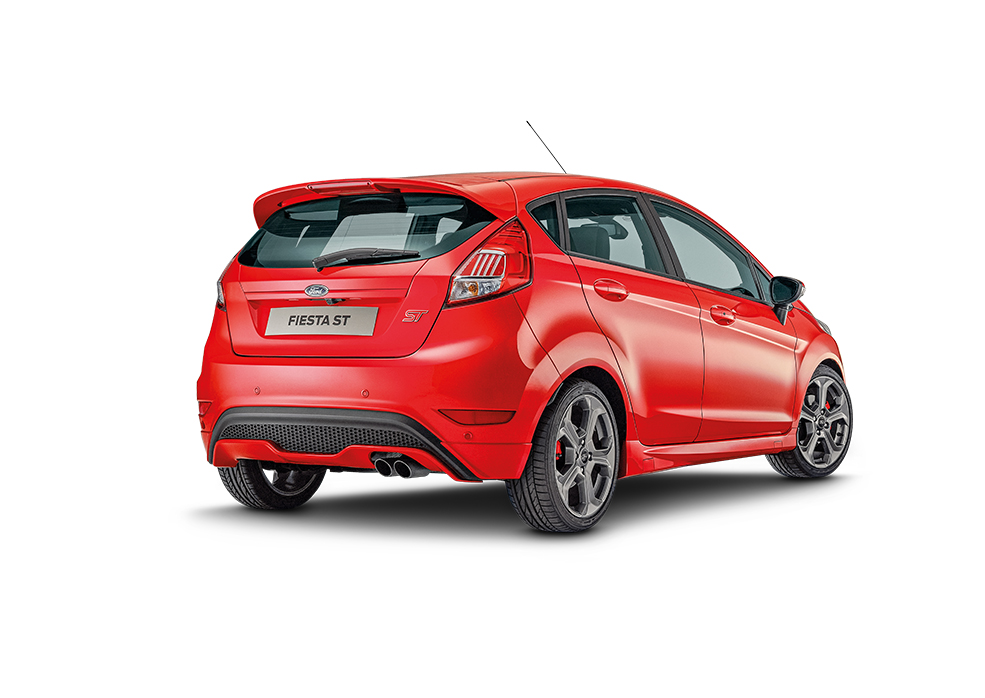
Ford Fiesta ST Mk7 exterior check points
Rust isn’t yet an issue on the Ford Fiesta Mk7 ST 180, but it’s surely only a matter of time before the rear wheel arches, sills and door edges start to bubble up. We’d also check for corrosion within the inner wheel arches, just in case.
Door seals have a tendency to drop off; contact adhesive is the cure. Front bumpers sag; a bolt can be added instead of the stock plastic fittings at the wings.
Fiesta paintwork is notoriously thin, so look out for stone chips and scratches. Most importantly, check for accident damage. There are loads of ST180s in salvage yards, and many more that have been repaired and returned to the road – not always involving insurance companies, so they’re not registered as write-offs.
Beware of bad repairs: look out for creases or splits in the floorpan or inner wings, mismatched paintwork, paint runs or orange-peel. Then stand back and check for poor panel gaps, and beware of overspray on any trim or under the bonnet.
Lighting
If fitted (ST-2/ST-3), make sure the LED daytime running lights (DRLs) are working properly. Failing DRLs tend to go dim when the indicators are operated, then don’t return to normal brightness when the flashers stop. Replacement units are the only answer.
Illuminated sill scuff plates (with the Style Pack) should light up whenever you open the doors, but they frequently fail – sometimes totally but often only half, or one side is dull. Repairs are possible, but complete replacements are usually required – and they’re dear.
If you’re viewing an early car, don’t forget LED rear lights weren’t fitted until September 2015.
Ford Fiesta ST Mk7 history
- July 2008 – Fiesta Mk7 launched, with production beginning at Cologne, Germany, in August and UK deliveries beginning in October. Zetec S is lukewarm sporting option.
- September 2011 – Fiesta ST debuts at Frankfurt motor show, boasting so-called torque vectoring system, tested at the Nürburgring and engineered to emulate a limited-slip differential.
- November 2012 – Facelifted Fiesta Mk7 (aka Mk7.5) introduced, with redesigned bonnet and headlamps, trapezoidal grille and revised tail lights.
- January 2013 – Fiesta ST launched, nicknamed ST180 thanks to 180bhp 1.6-litre EcoBoost engine. Specification includes uprated suspension, modified steering, 17in alloys, ST bodykit. Three-door bodywork only, but American-market (Mexican-built) STs have five-door body. Trim levels are ST-1 with plain upholstery; ST-2 with part-leather trim and LED daytime-running lights.
- February 2013 – Fiesta ST production begins at Cologne, Germany.
- July 2013 – Ford offers official Mountune 197bhp upgrade via 120 Ford dealers, priced £599 and covered by factory warranty.
- April 2014 – Fiesta ST-3 joins range, adding sat nav, cruise control, automatic headlights and rain-sensing wipers. All STs receive revised alloy pedals.
- September 2015 – LED rear lights now fitted to all Fiesta STs.
- July 2016 – Fiesta ST200 special edition released, produced in run of 1003 for UK. Based on ST-3 but with 197bhp, 236lb.ft, lowered final drive ratio (4.06:1), Storm Grey paintwork, matt black alloys. All Fiesta STs receive revised suspension settings.
- September 2016 – Five-door ST-2s and ST-3s on sale in UK.
- April 2017 – Fiesta Mk7 discontinued and replaced by Mk8, with a new Fiesta ST arriving in 2018. Total of Mk7 ST UK registrations: 30,625.
Guide from Fast Ford. Words: Dan Williamson

